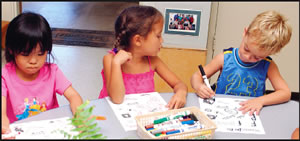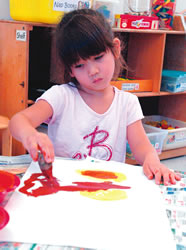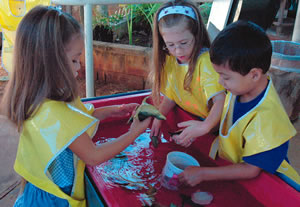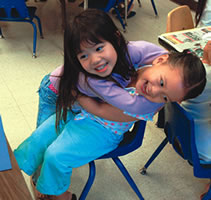Scrambling For A Preschool
Everyone agrees that preschool education is vitally important. The tough part is finding a good school for your child that you can afford

By .(JavaScript must be enabled to view this email address)
E-mail this story | Print this page | Archive | RSS

Kyra, Sophia and Deke from Unity
Between paying the bills, doctor visits, keeping the house clean and cooking a healthy dinner every night, studies show that parents also need to invest time and resources to prvide a good beginning for for their little ones’ education.
Research indicates that the first five years of a child’s life is the critical stage where experiences directly affect the development of the brain and lay the foundation for intelligence, emotional and moral health.
“Based on a whole bunch of research on brain development we know that 90 percent of a child’s brain growth occurs in the first few years of life,” says Alex Harris, policy director of The Good Beginnings Alliance. “Yet nowhere in the country is there a public commitment to children this young in the same way we commit to kindergarten and first grade.
“That time period in a child’s life is so important and we are just now coming to grips with that fact from a public investment standpoint.”
Good Beginnings is essentially Hawaii’s early childhood intermediary organization, set up by the governor’s office and the legislature seven years ago to help coordinate programs and services for young children before they get into the formal school system.
In a recent research project, Good Beginnings surveyed all public kindergarten teachers in the state and found that in Hawaii teachers believe that four out of 10 children are arriving in school not ready to learn.
“That reflects the fact that not all children are able to go to preschool or parents are too caught up with work to teach their children, and that gap in readiness begins then,” says Harris. We hear about it in terms of high school where kids are two to three grade levels behind. This is really where that begins and the reason we do this work — and that’s because we think we can prevent this from happening.”
The importance of early childhood education and efforts to prevent children from entering kindergarten unprepared has become a priority not only for parents, but
for the state. Gov. Linda Lingle recently released the Early Childhood Initiative to begin in July. The proposal is to allocate an additional $20 million in federal funds to the $100 million spent annually on child care programs; provide an additional $5 million in state assistance to allow more lowincome families the opportunity to enroll their keiki in quality child care programs; offer financial incentives for child care services to encourage preschool programs to adopt the Hawaii Preschool Content of Standards and hire teachers who meet established training standards thus improving the quality of preschool programs; work with community colleges to develop certified curriculum for people entering the early childhood system and allow and encourage preschool providers to use excess public facilities.

Kaethen Kahana and
Todd Cabanlet Jr. at
Kamehameha Schools
Ulupono Campus
With more than 200 early childhood education centers on Oahu, finding a facility that meets the needs and standards for each child shouldn’t be too hard, right? Wrong!
“Right now most preschool programs in the state are 90-95 percent full. So even if you can afford it, chances are you may end up on a waiting list,” says Harris. “What we’ve been working on with the legislature and the governor’s office is making it more affordable to parents and more universally available.”

Amelia from Unity
Of the 10 largest early child-care centers on Oahu — including Oahu Head Start, Kamehameha Schools, Kamaaina Kids, KCAA Pre-Schools, Seagulls Schools, Parents and Children Together, Rainbow Schools, Star of the Sea Early Learning Center, St. Ann’s Learning Center and Queen Emma Preschool — half are as maximum capacity.
“Our enrollment has really grown, reflecting I think what everyone knows to be about the importance of early childhood education,” says Suzanne Ramos, dean of Early Childhood Education for Kamehameha Schools. “It’s the realization that children really are our future.”
What this means for parents, is to start early and have a few alternatives.
Registration for most preschool centers on Oahu is a year in advance.
“It sounds silly, but as soon as your child turns 1, I would recommend parents to start looking,” says Jeanne Robinson, assistant director of Unity School. “We start accepting applications in September for the upcoming school year.”
Luckily, there are a number of resources available for parents who are looking for good quality child care.
PATCH , Hawaii’s statewide child care resource and referral agency, is a great place to start.
PATCH has well-devel - oped systems that helpsparents, providers, and local communities in find, plan for, and providequality child care. For parents, it provides up-todate referrals to family child care homes and centers, resources on how to choose quality child care and information on child care subsidy programs.

Anukea Ramos, Jordan Elicker and Aiden Han play with
sea creatures at Kamehameha Schools Ulupono Campus
For more information or to contact PATCH, call 839-1988 or log on www.patchhawaii.org.
Paying for quality child care is another obstacle that parents often struggle with and a major reason why parents often do not send their child to preschool.
With the average cost of child care in Hawaii at $400- $450 a month, this expense is often the second highest household expense after rent or mortgage.
“ The average cost of early childhood education on Oahu tend to be little higher than the rest of the state, and if the preschool is accredited the cost would be higher as well,” says Harris.
Local subsidy programs available include Head Start and Child Care Connection, which helps low-income families pay for child care; Preschool Open Doors, which specializes in helping families with children with special needs; Alu Like Native Hawaiian Child Care Assistance Project, for children 3 to 4 years old of Hawaiian ancestry; and the Pauahi Keiki Scholars Program, which is need-based for children 3 to 4 years old of Hawaiian ancestry in an approved and accredited preschool program.

Shantel Sanchez (left) and Alaina Kedro
With the current statewide push to increase enrollment by making preschool more affordable and available, it’s hopeful that the 55 percent of children in Hawaii who do not attend preschool will dramatically drop.
And with that, children will enter kindergarten ready to learn with a strong foundation for later school success.
“Basically you can invest now or pay later, and that’s the bottom line,” says Harris.
Page 1 of 1 pages for this story
E-mail this story | Print this page | Comments (0) | Archive | RSS
Most Recent Comment(s):








